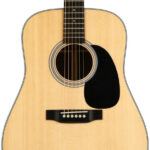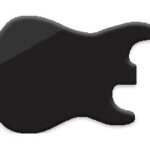Today’s guitar virtuosos on platforms like YouTube dazzle audiences with groundbreaking riffs and techniques, constantly pushing the boundaries of music. However, few realize that the instrument they wield – or its ancient predecessors – boasts a history stretching back to the dawn of civilization. For the aspiring guitar historian, understanding this rich past is as crucial as mastering the instrument itself.
The precise origins of the guitar remain shrouded in mystery. Linguistic roots trace the word “guitar” back to the ancient Greek term κιθάρα (kithara). Mythology credits Hermes with crafting the first kithara from a tortoise shell, though depictions of Apollo frequently feature him with this very instrument.
The kithara was characterized by a wooden soundboard and a box-shaped resonator body. Extending from this resonator were two hollow arms connected by a crossbar. Initially strung with three strings running from the crossbar to the base, passing over a bridge on the soundboard, later iterations expanded to as many as twelve strings.
Ancient musicians typically employed a plectrum, the ancestor of the modern pick, to strum the strings. The left hand served to dampen unwanted strings, and occasionally to fret notes or create harmonies. Solo performers sometimes plucked strings with both hands. The playing posture of the kithara mirrored that of the guitar, often utilizing a strap slung over the shoulder, a primitive guitar strap. For the discerning guitar historian, the kithara represents the foundational blueprint upon which centuries of stringed instrument evolution would be built.
 Ancient Kithara Instrument
Ancient Kithara Instrument
Tracing the Guitar’s Shape: A Journey for the Guitar Historian
From Prehistoric Echoes to Medieval Forms: The Guitar Historian’s Starting Point
The lineage of the guitar, as any dedicated guitar historian will confirm, can be primarily traced back to two instruments predating written history: the oud and the lute.
Legend attributes the design of the oud, an Arabian forebear of the guitar, to Lamech, Noah’s grandfather and the sixth descendant of Adam and Eve. The inspiration for the oud’s shape purportedly arose from Lamech’s somber act of hanging his deceased son’s body from a tree. The oud journeyed westward with the Moors during their invasion of Southern Spain in 711 AD, marking a pivotal migration in instrument history for the keen guitar historian.
The Guitar Historian’s Chronology: Shaping the Instrument from the 15th Century Onward
The lute, evolving in diverse shapes and sizes, generally featured a rounded back. Its journey traversed from Egypt to Greece and subsequently to Rome, where it was disseminated throughout Europe.
The earliest visual depiction of a lute-like stringed instrument emerges from Southern Mesopotamia – present-day Nasiriyah City, Iraq – dating back to 3500 to 3200 BCE. This ancient pictorial record portrays a woman seated in a boat, her hands positioned on an instrument in a manner clearly indicating musical performance. This image serves as a crucial artifact for the guitar historian, offering tangible proof of the instrument’s deep roots.
Pictorial records throughout Mesopotamian and Egyptian history reveal the continued presence of both long-necked and short-necked lutes. Museums such as the Metropolitan Museum of New York, the Philadelphia Museum of Art, the Cleveland Museum of Art, and the British Museum house numerous examples of these visual records on clay tablets and papyrus, invaluable resources for any aspiring guitar historian.
By the close of the Renaissance, the lute had undergone significant evolution, with some boasting up to 20 or 30 strings. However, the lute-like form began to wane in popularity. In the 15th and 16th centuries, Spanish musicians increasingly favored instruments exhibiting the curved silhouette that defines the guitar as we know it today.
These instruments, known as Baroque guitars, effectively supplanted the lute as the stringed instrument of choice for musicians from approximately 1600 to 1750. Refinements like five courses of gut strings and movable frets enhanced playability. For the guitar historian, the Baroque guitar marks a critical transitional phase.
The vihuela, distinguished by its incurving sides creating an hourglass-shaped body, gained prominence in Spain, Portugal, and Italy during this era. Mariachi ensembles still employ a contemporary variant of the vihuela, a testament to its enduring legacy, and a point of interest for the modern guitar historian.
The evolution of Spanish guitars solidified by the 1790s, establishing the standard body shape and six courses of strings resembling the modern guitar, albeit smaller in size. Spanish luthier Antonio de Torres Jurado revolutionized guitar design in the mid-1800s, crafting a style that became the archetype for all subsequent guitars. Many guitar historians regard him as “one of the single most important inventors in the history of guitar.”
Torres Jurado’s innovations included a broadened body, thinned soundboard, and an accentuated waist curve. He also replaced traditional wooden tuning pegs with machine heads. His pioneering approach to body construction and fan bracing – the internal system of wooden struts – endowed his classical guitars with their distinctive, resonant voice. Understanding Torres Jurado’s contributions is fundamental for any guitar historian.
Influential Spanish guitarist Andrés Segovia championed Torres’ classical guitar as a concert instrument. Segovia’s virtuosity and compositions, now recognized as “classical guitar” music, further cemented the instrument’s place in musical history. The impact of Segovia is another key area of study for the dedicated guitar historian.
Around this time, European immigrants introduced a steel-stringed version of the Spanish instrument to America. There, the modern guitar underwent further transformation, giving rise to the flat top, archtop, and modern electric guitar, marking a new chapter for the guitar historian to explore.
The Rise of Modern Guitars: A New Era for the Guitar Historian
The flat top acoustic guitar remains the most prevalent acoustic guitar form nearly two centuries after its inception. German-American luthier Christian Frederick Martin is credited with creating the flat top. Martin replaced the traditional fan bracing with X-bracing to enable the guitar body to withstand the increased tension of modern steel strings, a challenge for older Torres-style guitars. This innovation is a crucial turning point for the guitar historian to note.
The tighter steel strings of the flat top necessitated a shift in playing style, with guitarists increasingly using picks. This fundamentally altered the musical landscape for these instruments. Classical guitar melodies are characterized by precision and delicacy, while steel strings and picks facilitated brighter, chord-driven music. The widespread adoption of picks also spurred the development of the pickguard, now a standard feature below the sound hole on most flat top guitars, a detail observed by the attentive guitar historian.
Orville Gibson is widely recognized for the creation of the archtop guitar. This design incorporates f-holes, an arched top and back, and an adjustable bridge, enhancing the instrument’s tone and volume. Gibson fashioned guitar bodies resembling cellos to amplify sound projection. Jazz and country musicians rapidly embraced archtops, and big bands and swing bands also incorporated flat tops. The archtop’s emergence is a significant development for the guitar historian studying 20th-century music.
George Beauchamp and his partner Adolph Rickenbacker secured the first patent for the electric guitar in 1931. Simultaneously, numerous inventors and luthiers were developing electric versions of these instruments. Les Paul pioneered the solid body guitar manufactured by Gibson Guitars, and Leo Fender invented the Fender Telecaster in 1951. Together, the Fender Telecaster, Gibson Les Paul, and Gibson SGs represent the culmination of the guitar’s evolution into the solid-body electric guitars that dominate contemporary music. For the contemporary guitar historian, these electric models signify the latest chapter in a long and fascinating story.
Sources
https://www.ancient.eu/Kithara/
http://www.guitarhistoryfacts.com/guitar-inventor/antonio-torres-jurado/


